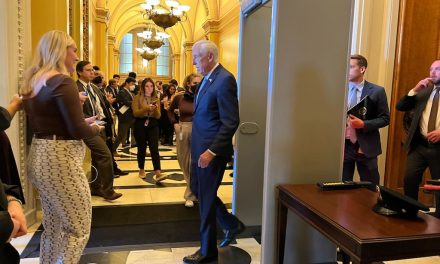By Megan Poinski
Megan@MarylandReporter.com
It is time for state governments to start owning up to the true value of their pension debt and make big changes to ensure that they can meet their obligations to retirees, an economist told a congressional committee Thursday.
Andrew Biggs, an economist with the American Enterprise Institute for Public Policy Research, said that state pension plans are doing worse than the states will admit. Biggs testified about what he called the flawed way states calculate pension obligations before the House of Representatives’ Oversight Committee.
Keith Brainard, research director for the National Association of State Retirement Administrators, countered that Biggs’ assessment is completely incorrect. He said that the way that pension liabilities are calculated is the most realistic way to look at the anticipated returns, and that those figures tend to be accurate when looking at the system over long periods of time.
According to estimates from state officials, Maryland has funded less than two-thirds of its pension system, and has an $18 billion unfunded liability. A revised pension plan passed by the General Assembly earlier this month increases contribution rates for all employees, and defers retirement and decreases benefits for those hired after July 1. Legislative analysts say that the new plan puts the state on track to funding 80% of its pension liability by 2023.
New accounting standards called for
Biggs said that because state governments use different accounting standards to calculate their pension obligations, they end up hiding the seriousness of the underfunding problem. A long-range 8% rate of return is calculated for many state pension systems, instead of calculating based on current interest rates. (Maryland uses 7.75%.)
“Economists believe that this is technically wrong, and potentially dangerous,” Biggs said in a conference call with reporters on Wednesday. “It allows the states to take excessive risks.”
Biggs said that states apply a different set of standards in calculating their obligations than private sector businesses. States tend to lean heavily on projected rates of return, he said, and report numbers that seem to be better than they are.
He estimated that if states were truly honest about their funds, they would show more than $3 trillion in unfunded pension liabilities – up from the $500 billion that is reported now. Current contributions would fund 40% of the system’s obligation, instead of the 60% funding that is reported. And in order for employees to contribute enough money to pay for pension benefits, they should be contributing 46% of wages to the system, not the average 12% that they pay now.
What Biggs described as “discounted reporting” by states leads them to make much riskier investments for their pension systems. If another economic disaster strikes, the states could be in trouble with the amount of money they actually have funding the systems. Plus, he said, riskier investments are considered having higher rates of return.
This means that using those rates of return, pension systems can say that they are better funded than the levels they actually are. He compared the way that states are approaching the investments to gamblers continuing to make risky bets, expecting to win back every penny they lost. With the risk involved, he said, it is more likely that the state may lose everything that way.
Current standards are the best, others say
The Governmental Accounting Standards Board (GASB) sets the rules for calculating pension liabilities. Brainard said that the way states calculate their liabilities tends to be accurate, even though the method is not used by the private sector.
Calculating an anticipated rate of return for the long run, Brainard said, gives pension systems some stability in their projections. And it isn’t just a stable projection; looking at investments pension systems have made over 20 and 30 years, Brainard said that they tend to post 8% rates of return or better.
On the other hand, calculations based on current interest rates make the pension system’s funds more volatile and less predictable.
“It drives up the cost,” Brainard said. “It overcharges current taxpayers, but then, undercharges future taxpayers as interest rates rise.”
Brainard also defended what Biggs called the “risky” investment strategy pension systems use. It is common for a pension system to purchase several different kinds of investments, ranging from traditional stocks and bonds to private equity and hedge funds. A system that has diversified its investments is actually seen as less risky — even though some components are generally seen as very risky — because it is made of more components. If one investment does extremely well or poorly, those gains and losses are balanced by the other pieces.
“By pooling your assets, you’re also pooling your risk,” Barnard said.
Maryland did not go far enough
While the General Assembly did not make any changes to the way that Maryland calculates its pension liability and debt, they did vote to increase contributions and cut new employees’ benefits.
Jeffrey Hooke, chairman of the Maryland Tax Education Foundation – a nonprofit focused on explaining the government’s financial decisions – characterized these changes as “nibbling around the edges” of the problem. What some members of the General Assembly thought they were making progress, Hooke described it as “doing very little” to remedy the root cause of the problem.
“They are still going to have a huge pension deficit problem, and will have to take more drastic action in the future,” Hooke said.
He said that the problem could be better solved by several things: higher employee contributions or taxpayer contributions, reducing benefits to employees, or a miraculous rebound in the stock market.
Last month, Hooke presented the General Assembly with yet another way that the state could save money on its pension system: indexing its assets instead of paying money managers, especially because returns on investments for the last 10 years have been poor. Hooke said this proposal likely got lost in all of the other proposed legislative actions coming before the body.
Hooke said it is important to for the state to invest more money toward the pension system now. By doing this, the state will win back employee trust, and it will be preparedfor future unpleasant economic surprises.
However, he doesn’t expect any further action to come in the near future. The next round of big changes, he predicted, would flow from the bond rating agencies.
“In a couple years when they knock Maryland down to an AA rating” is when the necessary change may come, Hooke said.






I think its time for this website to start telling both sides of the story. Many State government employees (especially, the professional staff) mainly came to work for State gov. years ago for the benefits. Salaries were much higher in private industry. The State promised those employees a pension if they stuck things out and dealt with all the red-tape one deals with in State government for 30 years. Now, because the politicians have squandered funds, and because of all the government bailouts, the State wants to renege on its promise to those employees who gave up 30 years of their lives to work for government and help serve the public. LET ME SAY, THAT THE CURRENT FISCAL PROBLEM IS NOT THE EMPLOYEES FAULT, THEY FULFILLED THEIR PART OF THE CONTRACT……IT’S THE STATE THAT IS RENEGING. What’s next ???? The legislative guarantee on the College Savings Plans? Sure, it’s guaranteed now, but what happens when they piss away more money and decide, well, we can’t really guarantee it anymore (we’ll just change the law or the rules). The State right now has ZERO credibility on monetary issues. O’Malley increases the take on State employee contributions from 5% to 7% but guess what ???????the extra funds are going to the General Fund and not the Pension Fund (fuzzy math, how about outright fraud??). It’s incumbent upon the press to start telling both sides of the story and stop beating up on State employees/retirees (although, I realize its a lot of fun for you).
The Governor and General Assembly made reasonable and constructive reforms to the pension system. It took 2% out of teachers’ and state employees’ paychecks and significantly reduced future benefits. But it puts the system on a path to solvency after two financial collapses have hammered to value of the funds.The anti-government activists who advocate for using a lower “risk-free” rate of return to project pension investments are outside the professional mainstream. They are (wittingly or not) part of a radical conservative movement to demonize our public employees, weaken their unions, and starve our public education, healthcare and regulatory systems.